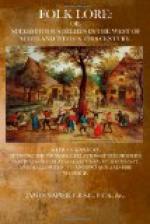The goat has been associated both in ancient and modern times with the devil, or evil spirit, who is depicted with horns, hoofs, and a tail. In modern times, he was supposed to haunt streams and woods in this disguise, and to be present at many social gatherings. He was popularly credited with assisting, in this disguise, in the instruction of a novice into the mysteries of Freemasonry, and was supposed to allow the novice to ride on his back, and go withershins three times round the room. I have known men who were anxious to be admitted into the order deterred by the thought of thus meeting with the devil at their initiation.
While staying at Luss lately, I was informed that a mill near to Loch Lomond had formerly been haunted by the goat demon, and that the miller had suffered much from its mischievous disposition. It frequently let on the water when there was no grain to grind. But one night the miller watched his mill, and had a meeting with the goblin, who demanded the miller’s name, and was informed that it was myself. After a trial of strength, the miller got the best of it, and the spirit departed. After hearing this, I remembered that the same story, under a slightly different form, had been told me when a boy in my native village. This was the story as then told:—A certain miller in the west missed a quantity of his meal every day, although his mill was carefully and securely locked. One night he sat up and watched, hiding himself behind the hopper. After a time, he was surprised to see the hopper beginning to go, and, looking up, he saw a little manakin holding a little cappie in his hand and filling it at the hopper. The miller was so frightened that this time he let him go; but, in a few minutes, the manakin returned again with his cappie. Then the miller stepped out from his hiding-place, and said, “Aye, my manakin, and wha may you be, and what’s your name?” To which the manakin, without being apparently disturbed, replied, “My name is Self, and what’s your name?” “My name is Self, too,” replied the miller. The manakin’s cappie being by this time again full, he began to walk off,




